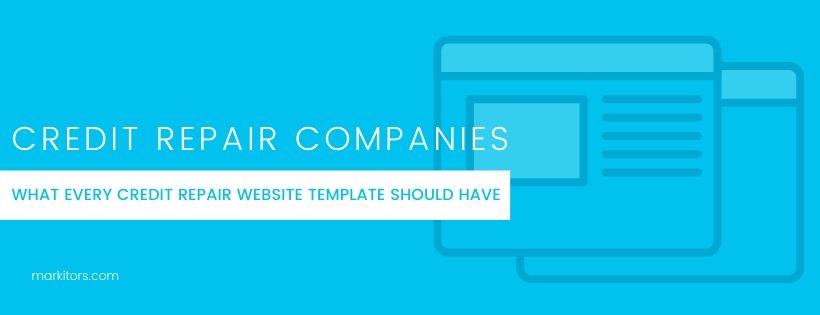
The credit repair industry is worth over $3 billion, according to data from IBIS World.
And unlike many other industries that are dominated by a select few giants, no one credit repair company holds any greater than 5% market share.
However, all of this opportunity has brought in significant competition. In fact, there are over 80,000 credit repair companies in the US alone.
Having a standout website can help your credit repair business separate itself from the competition. And that all starts with a quality credit repair website template.
Components of a good credit repair website template
So what are the components of a good credit repair website template?
The main elements are the home page, service pages, testimonials, FAQs, a blog, an ‘about us’ page, and a ‘contact us’ page.
However, perhaps the most important part of a good credit repair website template is that it is optimized for search engines. You see, just creating a new website won’t draw in the search traffic you’d like to see.
It takes a lot more thought than that. Still, including all of the following elements is the best place to start.
Homepage
A website’s homepage should draw in site visitors and be easy to navigate. First and foremost, that means having a well-structured site menu and site search functionality to direct visitors to your service pages—the bread and butter of any credit repair site.
Aside from that, your site’s homepage should contain a prominent call-to-action, including your phone number, address, and a ‘contact us’ form. It’s also a good idea to include offers, specials, discounts, and even a few five-star reviews from past clients.
Several prominent credit repair sites feature facts about the costs of bad credit to entice readers to use their services as well.
Go Clean Credit points out that with bad credit, it may be difficult to purchase a home.
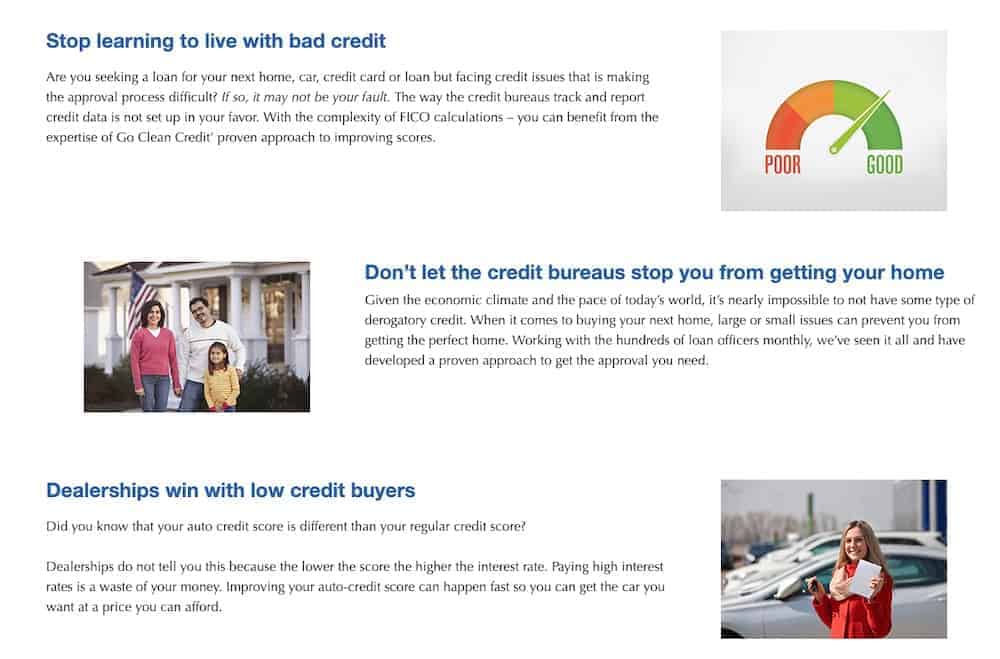 While some credit repair companies prefer to market their services by pointing out their low price options like CreditRepair.com.
While some credit repair companies prefer to market their services by pointing out their low price options like CreditRepair.com.
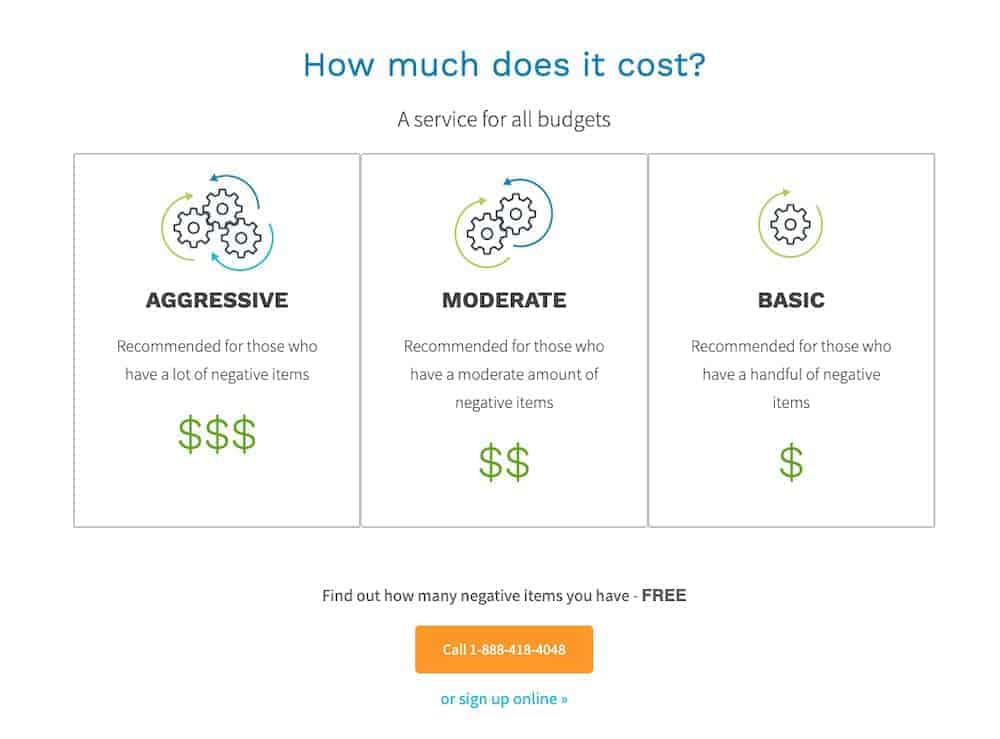 Both of these companies are trying to accomplish the same thing with these homepage additions—convert visitors to clients. So make sure your homepage isn’t bland and boring. In credit repair, homepages need to draw in business.
Both of these companies are trying to accomplish the same thing with these homepage additions—convert visitors to clients. So make sure your homepage isn’t bland and boring. In credit repair, homepages need to draw in business.
Service Pages
Services pages are the most important part of any credit repair website. A service page is where a potential client goes to sign up for and learn about the services you offer.
Without unique pages for each of your services, search engines will have trouble matching your business with potential clients searches. So, it’s crucial to build out your service pages.
Still, for a credit repair website, your main service page for general credit repair will get most of the traffic. So it should be easily navigable and offer all the information a potential client might need to make a purchase decision.
After that, you can begin to improve on-page SEO from HTML tags to site maps, but we’ll get to that later.
Testimonials
One of the best ways to convert visitors into customers on your website is by illustrating just how powerful credit repair services can be.
Ask some of your successful clients about their experience in a short email questionnaire. From that, you can develop your testimonials page.
All the top credit repair sites have testimonials prominently featured not only on their homepage but also on a unique testimonial page to draw in organic traffic.
FAQs
FAQs should be included in every credit repair website. Responding to commonly asked questions can save you a lot of time on the phone and help clients get their questions answered. More than that, though, it can give your website the chance to rank for what are called featured snippets.
When someone types a question into Google, the search engine will often produce featured snippets that take information from a website and feature it before all other organic search results.
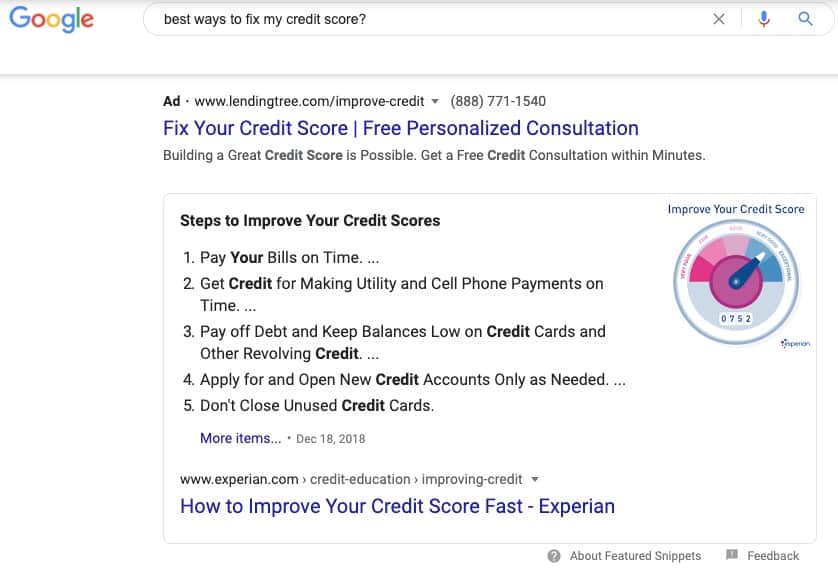
Featured snippets are great for organic website traffic and brand authority, so always include an FAQ page.
Blog
Having a quality blog is another necessity for credit repair sites—at least if they want any organic website traffic. There’s a reason why every major credit repair company has a well-managed blog.
They are an integral part of any successful SEO strategy. And, if they are based on keyword research, competitor analysis, and deep industry knowledge, they quickly draw in organic website traffic.
This blog from LexingtonLaw, one of the largest credit repair sites in the nation, appears on the first page of Google’s results for ‘how costly is bad credit?’
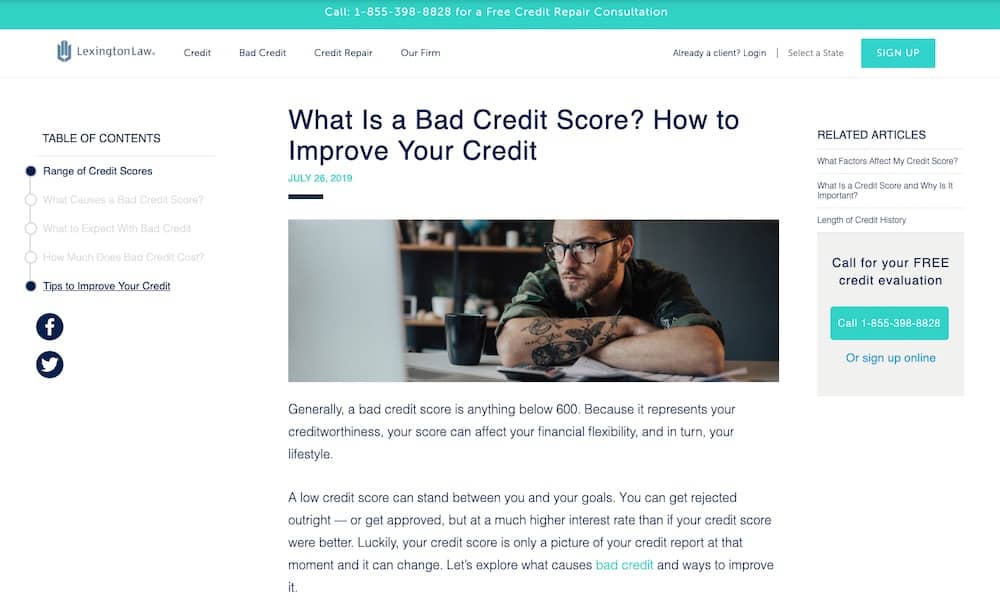 The cool thing about blogs is that if they are done right, the little guys can compete with industry leaders. Here’s an example from one of our clients Go Clean Credit featured just under the LexingtonLaw article.
The cool thing about blogs is that if they are done right, the little guys can compete with industry leaders. Here’s an example from one of our clients Go Clean Credit featured just under the LexingtonLaw article.
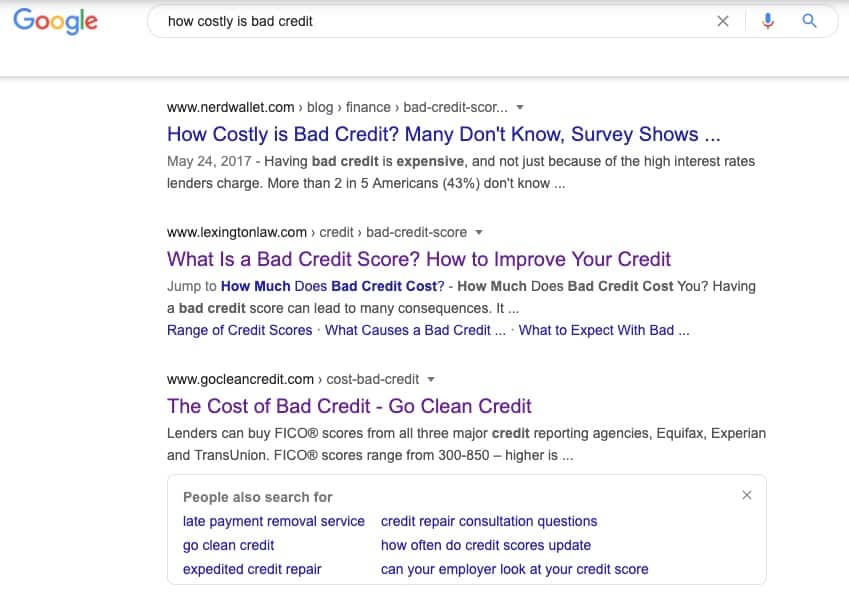
The reason the blog was able to compete with the bigger brand was because of SEO best practices.
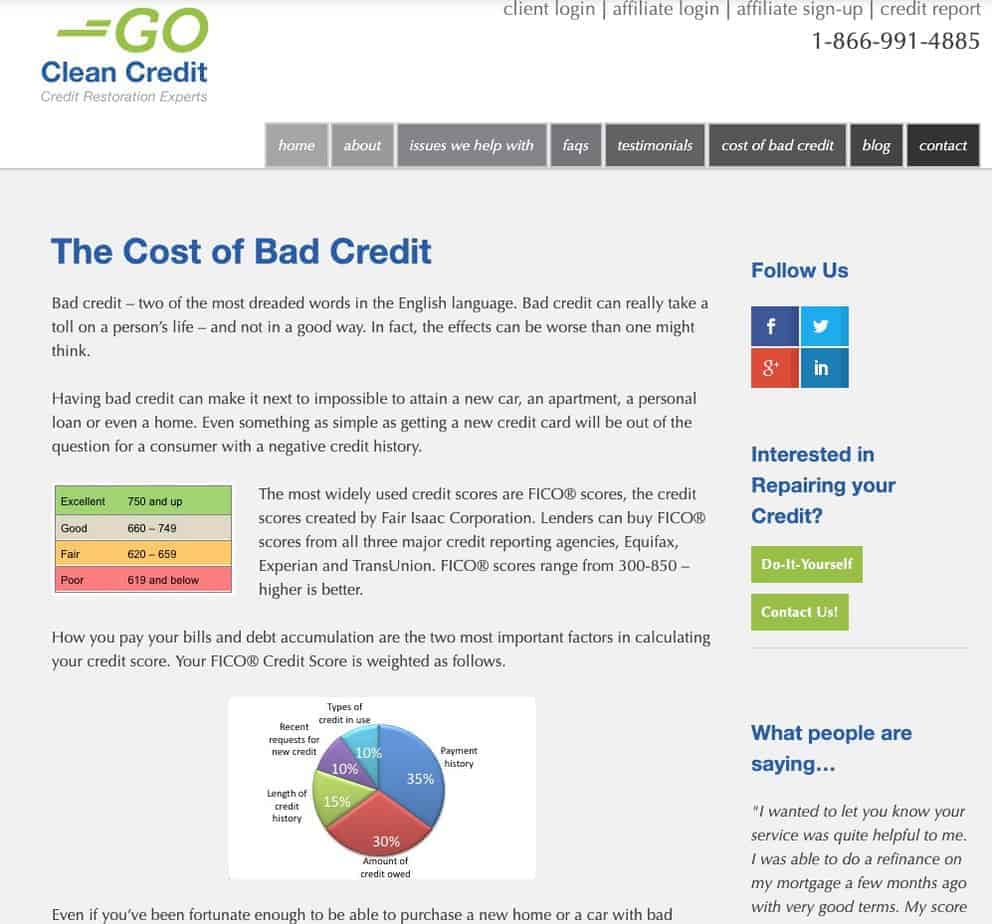 The article is filled with pictures, infographics, and formatting that entices readers to continue. Plus, its title tags, URL, meta description, and content have all been properly optimized for SEO based on an SEO strategy.
The article is filled with pictures, infographics, and formatting that entices readers to continue. Plus, its title tags, URL, meta description, and content have all been properly optimized for SEO based on an SEO strategy.
The blog is quality content for a human audience and for search engines—which means more organic traffic for the website.
About Us
The about us section is pretty self-explanatory. It should include your business’ name, address, phone number, email, and team, of course. But, more importantly, it should tell your company’s story in a human way to connect with potential clients.
Talk about how your business started, your first trials and tribulations, anything that helps to humanize your company and create a trusting relationship.
Contact Us
The contact us page should be separate from the about us page, and once again, its elements are fairly self-explanatory.
Put anything someone might need to contact your business with the touch of a button. An email address, phone number, physical address, and ‘contact us’ form or button are the standard fares here.
Search Engine Optimization
Unfortunately, even if you create a perfect credit repair website with all of the elements in the template, that won’t be enough to show up prominently in search engines without a search engine optimization (SEO) strategy and local SEO.
SEO is the process of increasing a website’s visibility on search engines, like Google or Bing, thereby improving organic traffic and increasing revenue.
SEO is a complex, time-consuming tactic, but here are just a couple of tips to get you started with SEO when designing a website.
SEO-friendly architecture
First, having an SEO-friendly site architecture is vital to moving up search engine results pages. It’s the only way to help search engines’ crawl’ (think: read) and then ‘index’ (think: categorize) your website.
-
- Create a site map.
- Use simple, consistent URLs.
- Ensure your website is secure which means HTTPS, not HTTP.
- Create an internal linking structure for search engines to crawl and index.
- Optimize for mobile devices.
Site architecture normally falls under the umbrella of technical SEO. So if you’re a little confused, try catching up with this article on the basics of What is Technical SEO?.
Analytics Tools
Perhaps, the best way to get started with SEO once you’ve created your site is to install Google Analytics and Google Page Speed Insights.
These free tools from Google help you monitor your site’s performance in terms of views, click-through rate, and site speed.
Once you’ve mastered Google’s analytics tools, you can take things a step further with advanced SEO analytics tools like GTMetrix and Ahrefs.
Of course, that can get expensive. It’s one of the many reasons why people often choose to use an SEO company after creating their website.
What to do after your website is up and running
The best thing you can do after getting your website up and running is to get some help to build out all the required pages from blog content to FAQs. The reality is that because of all the content you need to produce to get a website to rank, it’s just not a one-person job.
Of course, if you can’t afford to hire someone to work in-house, you can always hire a digital marketing agency to help get your website off the ground and build brand awareness.
Markitors is a digital marketing agency specializing in SEO. We help small businesses rank higher on Google to get more traffic to their websites and increase revenue. Explore what’s in our SEO toolbox: audits and keyword research, digital PR, technical SEO, and local SEO.








